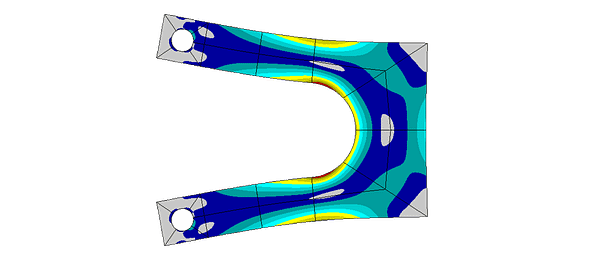Switching between linear and non-linear analyses in StressCheck’s Non-Linear Solver is seamless because of our simple element library. We treat elements and model definitions separately allowing the analyst the freedom to move between linear and nonlinear analysis after model formulation. No need to start over, no need to break the chain of analysis.
Non-Linear Solver

The Non-Linear Solver allows users to incorporate geometric and material nonlinear effects into elasticity analyses. Seamless integration with linear analysis is made possible by the hierarchic simulation structure upon which StressCheck is formulated.
Key Features and Advantages
Four different material laws supported to represent elastic-plastic material needs:
- Elastoplastic
- Bilinear
- 5-parameter
- Ramberg-Osgood
Material nonlinear analysis supports problems for which there are changes in material properties and plasticity must be assessed. The solver incorporates both the deformation theory of plasticity (for single overload events) and the incremental theory of plasticity for simulating multiple load-unload events such as during cold-working processes. It can perform a load step analysis to determine limit load at which there is unrestricted plastic flow.
Geometric nonlinear analysis support problems undergoes large displacements (and/or strain), ensuring equilibrium is satisfied in the deformed configuration. The user can switch from the default solver to the Newton-Raphson method for cases in which there is a strong coupling between membrane and bending forces.
The General nonlinear option combines the strengths of geometric and material nonlinear analyses (via deformation theory of plasticity) for problems undergoing both large deformation (and/or strains) and localized plasticity.
Material nonlinear with multi-body contact – StressCheck also supports the solution of an assembly for which one or more parts undergo localized plasticity (e.g. fastened joints, lugs, etc.). Dual iterative approach to update contact pressures as material plasticizes.
- StressCheck’s high-order elements are well suited for effectively and efficiently capturing non-uniform plastic boundaries as well as large structural rotations
- Transition seamlessly from a linear to a non-linear solution process by simply switching solvers
- Simple to check convergence of nonlinear analyses via StressCheck’s hierarchic framework
Looking for Resources?
Recent News & Events
Quick Links
Testimonials
-
“The p-type element has been used to great advantage in the finite element system ESRD StressCheck, [26]. This software provides the engineer with the means to conduct solution verification in an extremely straightforward manner by simply increasing the degree of the element, monitoring convergence and using Richardson extrapolation reliably to estimate the error. This can be conducted automatically by the software thereby enabling the engineer to concentrate on the engineering rather than the simulation. StressCheck has also been used to develop ESRD’s Handbook and Toolbox applications. The first of these provides engineers with a repository of parameterised standard problems of the type found in texts like Roark’s “Formulas for Stress and Strain”, [27]. The second, Toolbox, is a tool that can be used to parameterise a company’s range of components for rapid and reliable analysis by non-expert analysis. Toolbox then is an exemplary of the way in which the democratisation of simulation can be applied.”
Angus Ramsay, PhD
Engineering Director, Ramsay Maunder Associates
 Serving the Numerical Simulation community since 1989
Serving the Numerical Simulation community since 1989 





